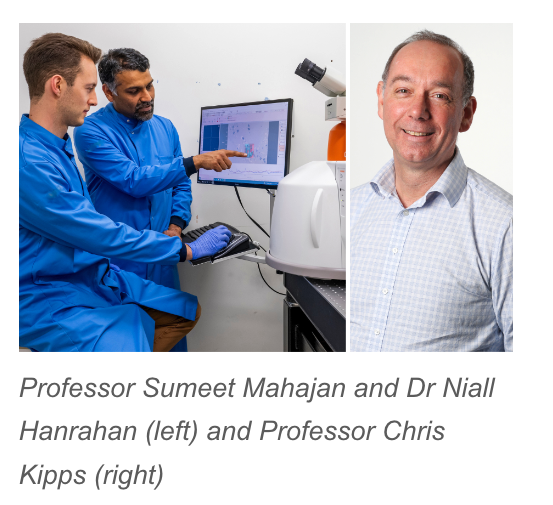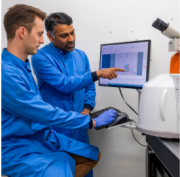日本語で読みたい方は、 google chromeで開き、
画面上で右クリックをして、「日本語に翻訳」をクリックしてください

Researchers are leading a pioneering study to investigate a new laser-based test that could detect different types of dementia early in the disease.
If successful, the test will help doctors rapidly identify which patients may be eligible for new drug treatments at a point when they are most likely to be effective.
The project is a collaboration between University Hospital Southampton (UHS) and the University of Southampton, funded by UK Research and Innovation (UKRI).
The test works by profiling a ‘biochemical fingerprint’ which experts believe can give an accurate diagnosis and help distinguish between different types of dementia.
The development has been hailed as a “breakthrough in medical technology” by the study team, with initial results suggesting accuracy of up to 93%.
There are over 850,000 people living with dementia in the UK with the figure is expected to rise to 1.4 million by 2040.
There are many different types of the condition, such as Alzheimer’s disease and vascular dementia, which is progressive and get worse over time.
Main symptoms include memory loss, difficulty in concentration, confusion, mood changes and language and problem-solving skills.
Diagnosing dementia early is difficult and often takes over two years using current diagnostic methods, with many people not receiving a diagnosis until a much later stage in the disease when treatment options are less effective.
One of the main challenges is that the disease has already progressed by the time symptoms start to appear and distinguishing between closely related dementia types can be challenging.
The new technology, known as Multi-excitation Raman spectroscopy (MX-Raman), uses lasers to analyse the composition of a single drop of a bodily fluid – this can be blood, spinal fluid or mucus.
The lasers create tiny vibrations within the molecules that can be probed and provide a unique signal profile – called a spectrum – allowing scientists to examine the proteins, lipids, metabolites and other biomolecules present in the sample.
Different molecules vibrate in different ways and this profile represents the sample’s biomolecular composition giving a ‘biochemical fingerprint’ of the person’s health and disease status.
The revolutionary test can provide results in seconds and would be much cheaper than other diagnostic tests currently available. It could also be made available directly in a clinic setting.
Initial results suggest the test can accurately detect dementia with an average accuracy of over 93% when diagnosing Alzheimer’s disease.
The project is called Holistic Optical Biomarkers to Transform Dementia Diagnosis (HOpE) and the research is being led by Professor Chris Kipps from University Hospital Southampton and Professor Sumeet Mahajan from the University of Southampton.
Prof Kipps, consultant neurologist at University Hospital Southampton, said: “The slow progression of dementia, with a long pre-symptomatic phase, presents a formidable challenge in early diagnosis.
“This laser-based technique could change the way we approach dementia diagnosis and may significantly improve affordability and efficiency of current biomarker analysis. It represents a breakthrough in medical technology.
“This innovation is not just a leap in healthcare quality; it’s a paradigm shift, redefining our approach to neurodegenerative disease in the clinic.”
The biochemical fingerprints generated by MX-Raman will be tested in groups of patients with different types of dementia to assess how this will benefit patients from new and emerging therapies that only work for certain types of dementia – such as Alzheimer’s disease.
Prof Mahajan, professor of molecular biophotonics and imaging at the University of Southampton, said: “Our integrated approach has the potential to revolutionise dementia diagnostics. There is an urgent unmet clinical need for more discriminatory, efficient and cost-effective solutions.
“Our holistic MX-Raman technique is uniquely equipped to address these challenges and we want to see this technology lead to vastly improved patient outcomes.”
Researchers are also aiming to create a portable prototype device to test different bodily fluids and demonstrate its ability to identify specific dementia types.
Paul Grundy, chief medical officer at University Hospital Southampton, said: “Research and innovation will be key to us addressing the most important health and care issues facing society.
“We are proud to have partnered with the University of Southampton for over 50 years, and this latest project is another example of when our experts come together from different disciplines.”
The study brings together research expertise in Southampton from medicine, chemistry, biology, engineering and computer science. This was enabled by the Southampton Imaging theme and the Interdisciplinary Dementia and Ageing Centre (IDeAC), both of which are supported by the Institute for Life Sciences at the University of Southampton.
The project is among the first to be funded by a new award from UKRI called the ‘Cross Research Council Responsive Mode’ – this supports emerging ideas from the research community spanning across many disciplines.
HOpE is one of 36 projects to receive this new funding out of almost 900 applications submitted by research teams across the UK.
The project will share £32.4m from the first round of UKRI scheme.
出典:
https://www.uhs.nhs.uk/whats-new/press-releases/scientists-develop-pioneering-diagnostic-laser-test-for-dementia
ご参考:
(株)光響が提供する製品・サービス情報:
・医療関連製品
In case of addition or removal of the article, please contact us as below:
info@symphotony.com
この情報へのアクセスはメンバーに限定されています。ログインしてください。メンバー登録は下記リンクをクリックしてください。

